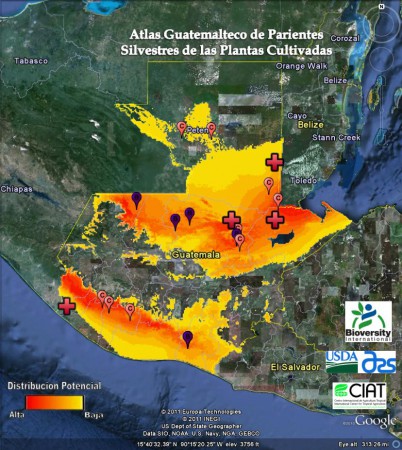Sad to hear that Dr Ed Percival, a world expert on cotton and its genetic resources, passed away last month. He collected wild and cultivated germplasm widely, and he was formerly curator of the USDA cotton germplasm collection at College Station, Texas, one of the more important in the world. ((Incidentally, College Station was hit by a tornado recently. There was some damage to the research station. The collections, which include trees such as pecan, were not affected, but this does serve to remind us all of the need for proper safety duplication of germplasm and associated data.))
Nibbles: Mike Jackson blog, Philippines genebank fire, Ancient garden, USA maps, Horse domestication, Gnats, Livestock training, Chocolate, Epigenetics, Indian nutritional security, Kew fund, GM bananas, Reconciling databases
- Mike Jackson gets himself a pulpit. Welcome to the blogosphere, Mike!
- More on the Filipino ex-genebank.
- What they grew in an ancient Israelite garden. Can they really tell Citrus species apart from their pollen?
- More American maps to mashup with obesity and food insecurity: land use, renewable energy sources…. I do hope someone is keeping track. Even of the more esoteric stuff, of course, like the names of softdrinks.
- Yet more on horse domestication.
- Another organic farming externality for your consideration. Thanks, Robert.
- ILRI gets innovative on this whole training thing.
- “The future of chocolate” revealed.
- Boffins look at fossil bison epigenetics to investigate adaptation to climate change. What will they think of next. Well, applying it to chickens, for a start.
- Other boffins move potato anti-nematode genes into bananas. No word on the epigenetics of it all.
- Indian report on how to strengthen role of agriculture in nutrition.
- Kew has money for fieldwork.
- Cleaning messy taxonomic data. Useful in Genebank Database Hell?
Nibbles: French seed policy, Coconut, Diversity conservation
- Le droit de planter et cultiver librement bientôt interdit? Not new, still important. h/t @plgepts
- Or, if you prefer, “French farmers will have to pay to use their own seeds“.
- Philippine Coconut Authority promotes value of coconut variety Tutupaen tall for its thick shell.
- Payments for Agrobiodiversity Conservation. New Agriculturalist does Bioversity scientist Adam Drucker proud.
Nibbles: Sweet potato value adding, Coffee and tree diversity, Spice and girls
- Sweet potato yoghurt? Yeah, ok, why not.
- Decreasing coffee production in Kenya can reduce tree abundance and richness on farm, but increasing production will lead to more trees but not necessarily more diversity. No, I don’t get it either, but have a look at the data yourself and try to figure it out. There’s plenty of it in this presentation.
- Love of hot peppers as benign masochism. Myself I think it’s a sexual selection cue.
Rounding up wild Guatemalan cacao accessions
…are there really no wild Guatemalan cacao accessions conserved in genebanks around the world?
I asked the question, so I better have a go at answering it, I suppose.
WIEWS shows no wild cacao from Guatemala, and actually not all that much cacao in Guatemala of any kind. GRIN returns 10 Theobroma accessions from Guatemala, but none of them are described as wild. The International Cocoa Germplasm Database (ICGD) returns 6 accessions from 4 localities. Here they are shown as crosses.
I got them into Google Earth via DIVA-GIS. The other icons show the distribution of herbarium specimens of wild T. cacao (C) and T. bicolor (B) and the predicted range of the former, according to the Guatemalan CWR atlas I blogged about yesterday. But you can’t tell from the data in ICGD whether the accessions represented by crosses are wild or not. Don’t worry though, there’s a reference given for all the accessions, so all is not lost: Rivera De Leon, S. (1986). Informe general sobre el proyecto de recoleccion de cacao Criollo en Guatemala. Unpublished report AGPG:IBPGR (FAO Rome)/86/156. Estacion de Fomento Los Brillantes, Guatemala.
It is an IBPGR report, so it should be available in the Bioversity’s Collecting Missions Files Repository. Which it is, although finding it was non-trivial. I’m not sure if that last link is going to last long, so look for collecting mission CN234. The problem is, I can see no way of attaching the description of the material given in the report to one or another of the accessions in ICGD. So although it does look from the report as though some of the material collected in 1986 may have been wild, I can’t tell you which if any of those crosses in the map above could legitimately be added to the Atlas of Guatemalan Crop Wild Relatives.
So the answer to the question I started out with is: I don’t know. I suppose it’ll take an expert in the crop to sort it out. You come up against this again and again in Genebank Database Hell. You can get so far, but to get any further you need human intervention.
